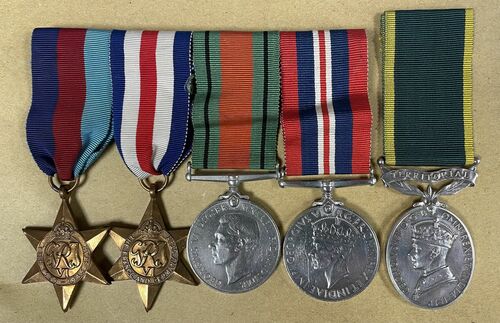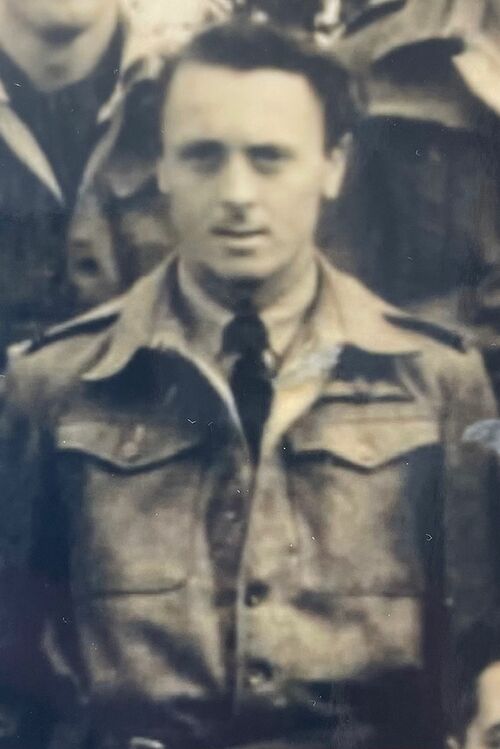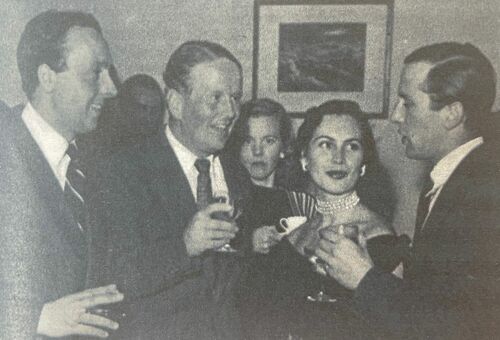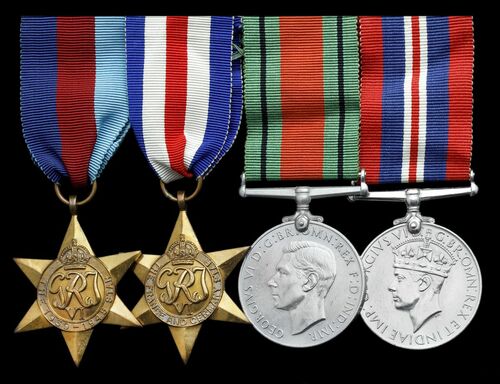Auction: 24002 - Orders, Decorations and Medals
Lot: 126
The campaign group of five awarded to Flight Lieutenant R. S. Clark, Royal Air Force, a Typhoon and Mustang pilot who flew extensive operations in a tactical reconnaissance Squadron in the advance from Normandy through Northwest Europe; he was also the recipient of the Efficiency Medal
1939-45 Star; France and Germany Star; Defence and War Medals 1939-45; Efficiency Medal G.VI.R., Territorial (F/Lt. R.S. Clark. R.A.F.), first four mounted as worn, good very fine (5)
Approximately 272 Efficiency Medals to the Royal Air Force.
Efficiency Medal London Gazette 4 July 1947.
Ronald Sidney Clark was born on 21 March 1921 at Whipps Cross, Essex and was commissioned 2nd Lieutenant on 10 May 1939 into the Royal Signals. He subsequently transferred to the Royal Air Force as a Pilot Officer on 19 August 1942. He was one of some 50 Army Officers who sought secondment to the Royal Air Force to undergo pilot training which he completed in Canada under the British Commonwealth Air Training Plan in 1942. Posted to No. 268 Squadron on 15 June 1944, having completed the tactical reconnaissance course at 41 Operational Training Unit at Old Sarum, he immediately commenced operations over the Normandy battlefields.
In July 1944, the Squadron re-equipped with Hawker Typhoon 1Bs and in early August 1944 the Squadron moved to the Continent and commenced a period of intense tactical reconnaissance coverage for the Allied troops as they fought inland including the Falaise Gap, the retreat over the Seine and the eventual pursuit of the Germans through Belgium and the Netherlands. One of his colleagues was Karun Krishna Majumdar DFC and bar who Clark flew wingman to on 18 August 1944 in Typhoon 1Bs, attacking roads and stationary motor transport in Normandy.
By 1 January 1945 the Squadron was located at Gilze Rijen in the Netherlands and scored one of its last confirmed air to air combat victories against German aircraft taking part in the massed air raid on Allied airfields that day. In April 1945 the Squadron, commanded by Squadron Leader C. T. P. 'Paddy' Stephenson (Medals sold in these Rooms in November 2023), moved from Mill to Twenthe and commenced re-equipment with the Supermarine Spitfire FR.XIVE, a reconnaissance version of the Rolls-Royce Griffon engined variant of the Spitfire, which was used with the remaining Mustangs, at that stage some Mustang Mk.IAs and larger number of Mustang Mk.IIs. The Squadron used these up to and after VE Day in May 1945; they continued in the occupying Allied forces and moved to Celle in late May 1945. In August 1945 the Squadron retired the last of its Allison-engined Mustangs after forty months. In mid-September 1945 they took on the specialist high-altitude reconnaissance Supermarine Spitfire PR.XIX, these aircraft being largely acquired by the transfer of a flight from 16 Squadron. On 19 September 1945, as a part of the general restructuring of the post-war RAF and repatriation of Commonwealth aircrew, the Squadron was disbanded at Celle in Germany and re-numbered No. 16 Squadron. Demobbed in August 1945 Clark became Director of a large furniture retailer in London.
Not finished with service, Clark joined No. 601 (County of London) Squadron serving for several years in Spitfires. He appears in The Tatler of October 1951 with other 601 pilots including 'Cats Eyes' Cunningham. Also pictured is Mena Adelaide Fosh, a model, who two years later married Clark. A few months after their marriage Mena sadly committed suicide at their home in Brighton following an alleged argument over a laundry bill. The tragic circumstances were to feature in most of the national press. Clark never remarried and also took his own life on 8 March 1994 at Park Farm, Henfield, West Sussex; sold together with copied research.
Subject to 20% VAT on Buyer’s Premium. For more information please view Terms and Conditions for Buyers.
Sold for
£650
Starting price
£200













